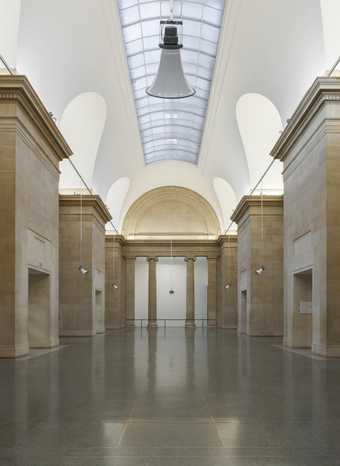[Music]
My name is Iain Sinclair. I am a writer. I mostly write about London, and I’ve come down to the City to experience the songs in the sound installation by Susan Philipsz’s. What is fascinating about this particular area is that it is this enclosure, the City of London, which separates itself from the rest of London. And what I like about this particular area where we are now in Moorfields is this feeling of an amphitheatre within a brutalist, sort of blank piece of architecture. Suddenly this pure voice erupts, and that is completely magical.
[Music]
An exciting thing is that even as you are in the streets below this, you can hear this music without knowing what it connects to, and that gives you an older sense of London when you might have come across such a thing; and that’s quite intriguing. You understand that time in the City is plural, and the Elizabethan voice can coincide with the contemporary voice.
[Music]
Milk Street Russia Row is really No Man’s Land. It’s somewhere visitors to the City wouldn’t go into. It’s off the main highway, and it’s a kind of cut through. It feels removed, it feels separate. It’s a very random, nondescript sort of place without identity. The City is deserted today, and the music has become absolutely an emanation of the fragmentation of this place; and John Dowland’s Lachrymae gives the thing an even more haunted and bizarre atmosphere.
[Music]
Susan Philipsz very much references disappearances as a theme. She chooses John Dowland for this point, ‘Flow My Tears’, and she is creating an elegy for the loss of London. Being here is to be as close as you are going to get at all to the sense of the Elizabethan and the medieval city – it was a city of bells. To walk about the City of London would have been a deafening experience, because bells were rung competitively in all of the different churches. So you were in an acoustic bell jar; and Susan Philipsz’s project is just a teasing memory of that.
[Music]
Below us is the river, but above us there is this great stone arch of a bridge which seems to be the access between life and death. The crossing of a river was always an immensely significant point in the primitive mind – the idea that if you crossed the river, you were going into the land of the dead. And all of those shuffling figures processing out over our heads are a chorus of the dead, a kind of angel chorus. It’s a very, very evocative point, and it’s in some ways the climax, I think, of the whole cycle.
In Change Alley there’s a total change in the atmosphere, and the song is ‘New Oysters’, so instead of that theme of tears and weeping and drowning, you’ve got the theme of the money and the dealing and the wheeling of the City. We are referencing the Royal Exchange, which is nearby, and we are referencing the things that come out of the river rather than the river itself – Change Alley is a crossover of all of these different streams of commerce. We are at the commercial centre of the City, and the song is very different for that reason.
The Silver Swan, by Orlando Gibbons, is really a madrigal of the end of an era. It’s about death, and Daniel Defoe records coming into Tokenhouse Yard in his Journal of the Plague Years, and seeing just a deserted city; and that is the theme echoed in this particular Susan Philipsz installation. The Silver Swan becomes the ghost-like emanation of the melancholy that has been haunting the whole project, and it comes to ground here in Tokenhouse Yard, and the Silver Swan, which is part of the song, comes into Tokenhouse Yard as into a harbour; and it’s the place where everything comes to an end. For the first time the reason for the melancholy is evident, and it’s death – it’s mortality. And it’s a song against dying, and against a dying city.
End of recording

